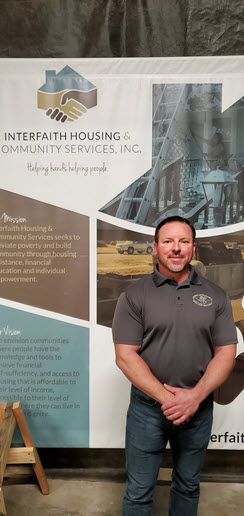President and CEO
External LinkInterfaith Housing and Community Services, Inc.
Hutchinson, Kansas

This interview is one of five conducted for an article about home repair in the Tenth District. The full article offers background information and links to all interviews.
The Kansas City Fed does not endorse any specific products or services.
Interfaith offers the John W. Scott Home Repair and Rehabilitation Program for homeowners over age 60 in Reno County, Kansas. The home repair program was the original founding program when Interfaith incorporated about 31 years ago. In a typical year, the program runs more than 10,000 hours of skilled volunteer labor annually, leveraging about $2,500 per project for materials.
2023 was not a typical year. That is when Interfaith entered into an agreement with Reno County for a portion of its American Rescue Plan Act (ARPA) funding, which will allow for up to $4 million total home repairs at a maximum of $25,000 per project. These projects are targeted to seniors (55+), although they have also completed some urgent health/safety repairs for younger homeowners. Interfaith is using paid contractors for the work rather than volunteers. As of December, Interfaith has 245 qualified applicants with $1.64 million in capital spent so far. About 70% of clients live within the city limits and about 30% live in outlying rural areas.
Q: Your traditional home repair program, the John W. Scott Home Repair and Rehabilitation Program, focuses on people over 60. Tell us about your clients.
A: The projects that stand out are those where the clients are isolated and disconnected from resources and from the community. Our staff’s goal is to meet them where they are and build a level of trust in connecting them to resources. At the same time, they can evaluate their housing situation and starting to formulate a plan for improvements to the property. The impact is tangible. It’s the new roof or wheelchair ramp or bathroom they can maneuver around in and utilize. Those can be seen. And there is also the connection and relationship building and having someone they can call on, that’s life-changing for the individual.
Q: When it comes to the system related to the rehabilitation of homes what challenges do you see?
A: The first thing that comes to mind is protecting the unit from falling into rental. It happens through attrition, such as when the elderly owners move or pass away, and adult children who don’t live here are left to handle the estate. Quite often if it’s a smaller cottage or ranch it’s easier for the adult survivors to liquidate that at a bargain price. That’s been a trend in Hutchinson.
Hutchinson has a strong rental market. There are always people who are looking for rentals. As a byproduct, a lot of investors don’t have to maintain those houses at a high level to attract occupants. In Hutchinson, that has been a pivot point for a lot of the housing stock, the point at which it went from homeownership to rental.
Q: You must have worked on many of the homes in Hutchinson over 30+ years. What impact has Interfaith had on the housing stock in your community?
A: In our time performing work here, we have touched more than 1,000 residential properties. We have never, though, been able to stay ahead of the pace of deterioration. One thing we’re experiencing currently with ARPA is that, with the appropriate level of funding, there are systems and opportunities to at least hold pace if not prevent deterioration. It has always been a lack of funding that has prevented us from really doing the volume of work that’s needed.
Q: That has changed now, with the ARPA funding. How did that come about?
In 2022, Reno County used public input to decide what our priorities were for ARPA initiatives. The three priorities are childcare, economic development and housing. Interfaith requested and received $4 million of local ARPA funds to expand our home repair and rehab programs, not just in project count but in the funds per project.
We began marketing that program in March of this year and I would say the program has by far exceeded our expectations as far as the need and homeowner participation, with nearly 250 applicants. We’ve never had this level of funding to perform roof replacements and to make upgrades to electrical and plumbing systems and really address health and safety issues in the older housing stock. As with all the ARPA funding, we have until the end of 2026 to expense the entire amount. We believe the entire $4 million may be spent down by the end of 2024. At that point, our programs either scale back to their previous performance or we’re hopeful that we can find appropriate funding to continue with this level of work.
Q: What would it take to continue at this level?
A: I would hope that our decision makers at the state level are taking note of that need to fund housing, not only new development but stabilizing existing housing stock. That needs to continue to be a priority. The demonstration that has happened through this rare funding opportunity shows that if we have $1 million or $2 million a year, this is the volume of work that we can perform. This is a sample of what we can do.
The results of this program can be seen not only in terms of stabilizing the housing stock but also in the community conversations that are happening and new partnerships. There are new collaborative efforts to celebrate what’s going on with ARPA and to discuss what is the next step, post-ARPA. There has been so much positive momentum, we hate to lose that. I believe we’re learning what would be the long-term solution to issues we’ve been talking about for the last 20 years. It sounds like we’re on a path to new direction in housing stability. Again, it takes appropriate funding. It all starts there.
